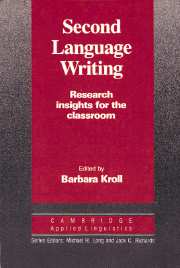Book contents
- Frontmatter
- Contents
- List of contributors
- Series editors' preface
- Preface
- Introduction
- I PHILOSOPHICAL UNDERPINNINGS OF SECOND LANGUAGE WRITING INSTRUCTION
- II CONSIDERATIONS FOR WRITING INSTRUCTION
- Chapter 7 Composing in English: effects of a first language on writing in English as a second language
- Chapter 8 The teaching of topical structure analysis as a revision strategy for ESL writers
- Chapter 9 What does time buy? ESL student performance on home versus class compositions
- Chapter 10 Feedback on compositions: teacher and student verbal reports
- Chapter 11 Teacher response to student writing: focus on form versus content
- Chapter 12 Responding to different topic types: a quantitative analysis from a contrastive rhetoric perspective
- Chapter 13 Writing with others' words: using background reading text in academic compositions
- Index
Chapter 7 - Composing in English: effects of a first language on writing in English as a second language
Published online by Cambridge University Press: 05 October 2012
- Frontmatter
- Contents
- List of contributors
- Series editors' preface
- Preface
- Introduction
- I PHILOSOPHICAL UNDERPINNINGS OF SECOND LANGUAGE WRITING INSTRUCTION
- II CONSIDERATIONS FOR WRITING INSTRUCTION
- Chapter 7 Composing in English: effects of a first language on writing in English as a second language
- Chapter 8 The teaching of topical structure analysis as a revision strategy for ESL writers
- Chapter 9 What does time buy? ESL student performance on home versus class compositions
- Chapter 10 Feedback on compositions: teacher and student verbal reports
- Chapter 11 Teacher response to student writing: focus on form versus content
- Chapter 12 Responding to different topic types: a quantitative analysis from a contrastive rhetoric perspective
- Chapter 13 Writing with others' words: using background reading text in academic compositions
- Index
Summary
Traditionally, ESL teachers have emphasized the need for ESL writers to think and write as completely as possible in English. The belief is that if ESL writers do any of their work in their first language, this will inhibit acquisition of the second language (L2) and will interfere with the generation of L2 structures, due to transfer of structures and vocabulary from the first language in an incorrect way. For instance, Arapoff (1967) suggested that students should avoid topics related to firsthand experience because they may then translate from their first language into English.
However, a number of studies have indicated that, regardless of a language prescription, writers will transfer writing abilities and strategies, whether good or deficient, from their first language to their second language. Mohan and Lo (1985), for instance, cite a study by Das which indicated that students had similarly deficient rhetorical strategies in their first language and in English. In other words, students who lacked first language strategies displayed a similar lack of strategies for writing in their second language. Mohan and Lo suggest that this deficiency may be developmental – students who have not developed good strategies for writing in their first language will not have appropriate strategies to transfer to their second language. Edelsky's study (1982) of the writing of first, second, and third graders in a bilingual program also indicates that writing knowledge transfers across languages. Her results show that writers use first language strategies and knowledge to aid their second language writing.
- Type
- Chapter
- Information
- Second Language Writing (Cambridge Applied Linguistics)Research Insights for the Classroom, pp. 109 - 125Publisher: Cambridge University PressPrint publication year: 1990
- 57
- Cited by

